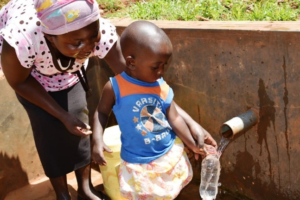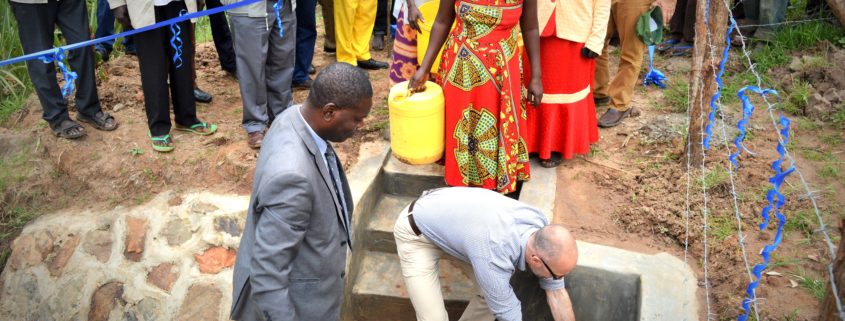Water Source Protection Improves Water Quality/Quantity in Kenya
Approximately 95 percent of residents in Silula Village, in western Kenya, obtain their drinking water from springs and rivers. Yet the majority of these sources are unprotected from pollution. Water typically flows from the spring eye to be collected meters away. This route exposes it to fecal contamination, domestic activities such as washing of clothes and utensils, and agricultural runoff.
In November 2016, community members took part in a USAID-supported initiative to promote conservation of key water sources in Siaya County by protecting and strengthening of Water Resources User Associations (WRUAs). WRUAs are voluntary membership associations made up of water users and riparian owners interested in proper management of their water resources.
Enthusiastic community members contributed fencing posts, bricks and hardcore to secure the spring intake and unskilled labor to clear and improve the access path to the spring. The benefits of protecting and conserving the spring were experienced immediately. The bacteriological quality was improved by the physical barriers of the spring catchment, which target water directly to the spring eye. The physical quality, including turbidity, is also controlled in the same way because no sediments can escape the outlet pipe. The flow rate was increased due to a build-up in water pressure behind the spring catchment wall.

Naima and her young daughter get drinking water from the protected spring in Silula Village, Siaya
Source: Eric Onyiego/KIWASH
“Long queues at the spring are unheard of now. My 20 liter jerry cans fill up within just two minutes! Moreover, my family of four now uses five jerry cans per day up from the two we used to queue for so long to fill up,” Naima Mohammed, 23, says. Much has changed since her original trips of over 90 minutes every other day to collect water even though the spring was only 300 meters from her home.
These changes improved the quality and quantity of water available to over 700 community members. The protection of the Silula Spring also encouraged community members to register as voluntary members of the WRUA. As a part of this membership they made commitments to carry out a wide range of activities contributing towards better watershed management. For example, avoiding activities on demarcated riparian areas, carrying out soil and water conservation activities, planting trees, and controlling water pollution.
KIWASH Project
The 2015-2020 USAID Kenya Integrated Water, Sanitation and Hygiene (KIWASH) Project works with local communities, county water offices and decision-makers. The project aims to improve community representation in WRUAs within sub-catchments to increase sensitization on integrated watershed conservation and water resources management. The project also aims to build the capacity of county governments and institutions to expand source water protection and improve water access.




Leave a Reply
Want to join the discussion?Feel free to contribute!